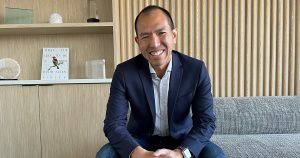
Peter Shen ’99, Biomedical Engineering
As the North America head of digital health at Siemens Healthineers, a health care solutions company, Peter Shen regularly engages with major health providers and technology partners on issues around adopting innovative technologies in health care. A Johns Hopkins Leadership Fellow for the Whiting School of Engineering, he recently testified before Congress about artificial intelligence in health care.
1. Tell us about your work at the intersection of health care and technology. How can the latter broadly enhance the former?
It’s the best of both worlds for me— two areas that I’m really passionate about—and now I have the opportunity through Siemens Healthineers to inform doctors and hospitals that “Hey, there’s a lot of great technology out there that could help your patients going forward”—everything from data analytics to digital ecosystems and artificial intelligence that we can make practical in the health care arena.
You look at health care as an industry and it’s actually quite behind as it relates to technology. The things we do on a daily basis in our personal lives with technology, like requesting services, banking, communicating— you don’t see that same level in health care. There are good reasons for the slow adoption of technology in health care, primarily because the stakes are higher; we’re talking about patients’ lives, so it’s good to pump the brakes and have guardrails in place. At the same time, it’s an industry that could really benefit from these new and emerging technologies and platforms. 
2. How can AI boost health care?
The industry is strained, partly because we have an aging population that requires more from a health care standpoint. That population’s growth rate compared to the rate of the number of new doctors, nurses, clinical technologists, and other caregivers is not the same. To address this growing workforce gap, we’ve got to figure out a way to be more efficient and maximize the limited time these resources have. AI can help take care of mundane, repetitive tasks so caregivers can do what they do best, which is focus on the patient. It’s a big driver for us as an organization, with the patient at the center of everything we do.
It’s also important to think about using these technologies not just to fill gaps but to augment what’s already there. Patients still trust their doctors, and we want to maintain that trust by helping doctors make better-informed diagnostic decisions and provide more personalized treatments through technology. We have AI solutions delivering quantitative and qualitative clinical information that doctors would not normally have. We need to make sure there’s ubiquitous access to this technology for all patients as well—not just at large health centers in the big cities, but also hospitals, in rural areas, and for underserved populations.
3. How did you get interested in health care and how did Johns Hopkins nurture that interest?
I grew up in Rochester, Minnesota, a small town that’s known for the Mayo Clinic. My father was an engineer and my mother was a laboratory technologist, so I had an early gravitation toward technology and health care. I heard through friends and relatives: “Hey, there’s this place Johns Hopkins that is kind of good at these types of thing!” [Laughs]
All that led me to my time in Baltimore and I loved every minute of it. I had the opportunity to meet professors and clinicians doing biomedical engineering research and I even got to scrub into the surgical suite during open-heart surgeries. As I reflect on my time at Hopkins, certainly I treasured those experiences, but also now appreciate some of the diverse courses that I took outside of biomedical engineering that really influenced me. I remember my Writing Seminars and history courses, where I learned valuable communication skills and the ability to articulate complex concepts, which has become so important in the role I have today.




